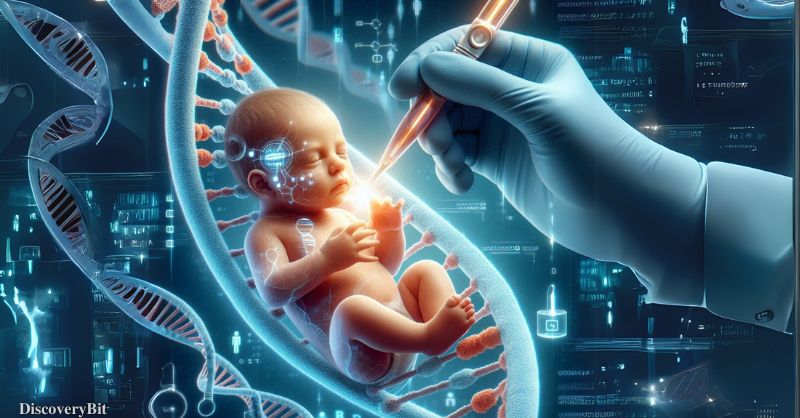Can you recall seeing some of your friends with a similar brand of bag, shoe, or phone, but with a little something extra that differentiates them? For example, unique colors, name tags, bedazzlements, or, in the case of a phone, the apps and casing types. These extras are referred to as designing to specification.
Now, imagine applying this concept to human beings. What if, instead of customizing phones, shoes, and bags, we could customize human beings by editing certain genes to include or exclude specific traits, ensuring they meet our desired health standards? Mind blown yet!?
Okay, stop. Let’s not get ahead of ourselves. Before we go any further, what exactly are we talking about?
How Is It Possible to Design a Human?
Designing a human being can be likened to the test-tube baby process but with a touch of “wonder.” The test-tube baby method involves fertilizing female eggs with male sperm in a lab before implanting them in a woman’s uterus, where they develop into a baby.
Now, imagine that after fertilization, the embryos are customized or edited using a revolutionary tool known as the “cluster regularly interspaced short palindromic repeat” or simply CRISPR gene editing—the spice of wonder. This tool allows scientists to remove or modify genes associated with diseases, potentially creating healthier humans. For instance, genes linked to hereditary conditions like sickle cell disease or beta-thalassemia could be edited out, offering a chance at a disease-free life.
What Is CRISPR Gene Editing?
CRISPR gene editing is a groundbreaking technology that enables precise modifications to DNA. It works using two main components: a guide RNA (gRNA) and an enzyme called Cas9. The gRNA is a pre-designed DNA replica that binds itself to the exact DNA structure to be altered; in other words, it directs Cas9 to the exact location in the DNA that needs editing, and Cas9 acts like molecular scissors, cutting the DNA. This creates an opportunity for scientists to add, remove, or alter genetic material during the repair process. Sounds pretty cool, right!?
But is all this really worth it? Have scientists discovered and fully understood the relationships between genes and hosts of known diseases to determine which ones to alter correctly?
Recent advancements in CRISPR technology have expanded its applications. For example, CRISPR has been used to treat genetic disorders like sickle cell disease and beta-thalassemia. It has also shown promise in combating cancer and rare metabolic conditions. Researchers are even exploring its potential to edit genes directly inside the body (in vivo), which could make treatments more accessible and cost-effective.
The Gene-Disease Relationship
Scientists have made significant progress in understanding the relationship between genes and diseases. Here are some examples:
1) Alzheimer’s Disease: Recent studies have identified genes like PLCG2 and AB13 as key players in the development of Alzheimer’s. Though many genes, that relate to the disease, have previously been discovered; however, these two genes are better understood, paving the way for more effective treatments.
2) Inflammatory Bowel Disease (IBD): Over 200 genes have been linked to IBD, but recent research has pinpointed specific genes directly responsible, offering new avenues for targeted therapies.
3) Heart Disease: Approximately 50% of the risk for coronary disease is attributed to genetic factors. However, some of these genes are also linked to reproductive success, raising ethical questions about editing them.
4) Primary Hyperoxaluria Type 1 (PH1): A recent breakthrough in gene editing therapy has shown promise in treating PH1, a rare genetic disorder. Using CRISPR-based technology, researchers were able to deactivate specific genes responsible for the disease, significantly improving patient outcomes.
Ethical and Practical Concerns
All the above examples, though, emphasize the need to embrace the gene-editing method as a means of eradicating some terrible and incurable diseases, but again, do we fully understand these disease-gene relationships to determine what genes to edit?
While the idea of eradicating diseases through gene editing is promising, it’s not without challenges. For instance:
Unintended Consequences: As previously noted, some genes associated with diseases may also play vital roles in other biological processes. Editing these genes could have unforeseen effects. And we wonder why nature did not naturally eliminate these genes through the process of natural selection. Are we so arrogant as to think that we can do nature’s job better?
Lifestyle Factors: what if we were able to eradicate the genes, which are related to these diseases, does it then imply that the genes are the only contributing factor to someone having, for instance, a heart disease? What about a person’s lifestyle, for example, smoking and dietary intake? In other words, does eradicating an incurable disease by editing the related genes of an unborn child, at the rudimentary stage of development, actually stop someone from contracting the same disease through other means? Some would say a BIG NO to that. Gene editing is not a cure-all.
Ethical Dilemmas: Should we interfere with nature? Critics argue that we may be overstepping by attempting to “improve” on natural selection.
Cost and Accessibility: While CRISPR-based therapies are advancing, their high costs could limit accessibility. Efforts are underway to develop more affordable in vivo gene-editing techniques.
Conclusion
The potential of CRISPR gene editing to revolutionize healthcare is undeniable. However, as we move toward embracing this technology, thorough research is essential to understand the full implications of editing human genes. Until then, caution is advised as we navigate this exciting yet complex frontier.
What’s your take on this? Should we fully embrace gene editing, or are there other perspectives we should consider?
Tags: CRISPR crispr cas9 gene editing crispr gene editing Disease DNA Embryo Gene editing what is crispr gene editing






